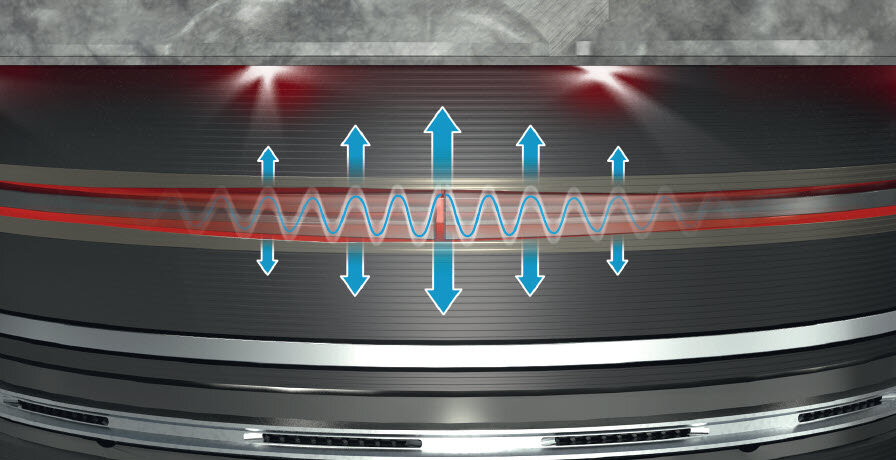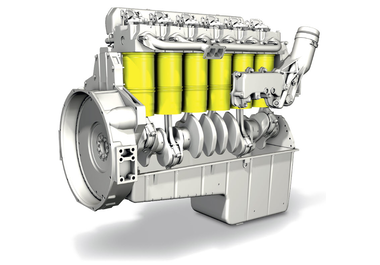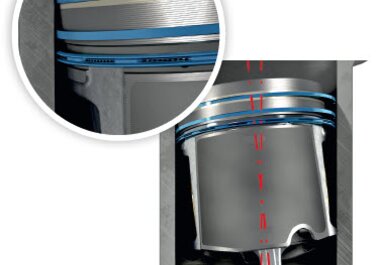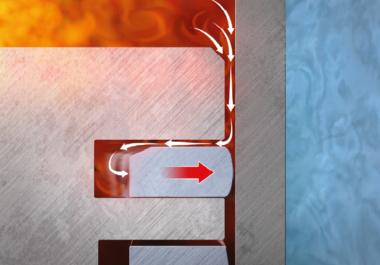
Sealing problems and piston ring damage
Ring flutter
Information on diagnostics
Ring flutter results in loss of power and high oil consumption. But what actually is ring flutter? What types of ring flutter are there? What are the reasons for axial and radial ring flutter? You can find out plenty of information here.
Ring flutter can occur in particular on petrol engines under medium load and at high speeds. Fluttering refers to both the lifting of the piston ring off the bottom flank contact area and the loss of sealing effect on the ring due to the loss of radial contact on the cylinder wall (collapsing). Both result in loss of power and high oil consumption, as the sealing function is impaired or eliminated completely.
AXIAL RING FLUTTER
Axial ring flutter is usually initiated in the ring from the joint ends. Due to their exposed position, the joint ends are particularly susceptible to lifting off the bottom contact surface
under unfavourable conditions. The joint ends set into vibration then transfer the vibration in waves over the entire piston ring.
ATTENTION
 |
Due to the lower inertial force, low ring heights have less tendency to flutter. Higher contact pressure on the joint ends counteracts the tendency towards fluttering. |
Reasons for axial ring flutter
- Excessive ring height clearance
- Loss of ring tension (wear), resulting in poor pressure behaviour on the joint ends, particularly with piston rings with pear-shaped radial pressure distribution
- Mechanical contact of the piston with the cylinder head due to reconditioning errors, particularly on diesel engines (Fig. 1)
- Knocking combustion due to errors in the engine management (mixture formation, ignition) and due to inadequate fuel quality (octane rating too low, diesel admixtures)
- Worn piston ring grooves
- Groove base gas volume too low due to carbon deposits in the groove base (cause: combustion temperatures too high) and /or inadequate engine oil grades
RADIAL RING FLUTTER
An excessive increase in the gas pressure on the piston ring sliding surface during combustion (Fig. 2) disturbs the balance of forces briefly, the piston ring is lifted off the sliding surface and can no longer seal correctly. The constant repetition of the process leads to fluttering on the piston ring.
Reasons for radial ring flutter
- Worn piston rings (reduction in the radial wall thickness) and an associated loss of pressure force between the piston ring and cylinder wall, as well as reduced ring stiffness
- Out-of-true cylinder bores and an associated increased ingress of combustion pressure in the sealing gap between the piston ring sliding surface and ring gap
- Asymmetric piston wear pattern due to bent connecting rods: The ring follows a slightly oval shape due to the out-of-plumb positioning inside the cylinder bore. This means that a higher level of combustion gas enters the top land area and between the piston ring and cylinder wall on the cylinder side with less piston contact
- Excessive, crowned wear on the sliding surface of the piston ring due to excessive ring height clearance
- Damaged ring edges caused by incorrect honing (peak folding formation): The ring is torn open and frayed on the ring edges (mainly on simple cast rings without a surface coating), gas enters the sealing gap and lifts the piston ring off the sliding surface.


